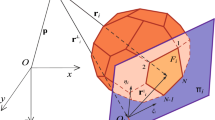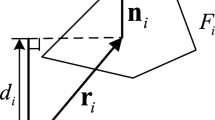Abstract
A polyhedron can model irregularly shaped objects such as asteroids, comet nuclei, and small planetary satellites. With minor effort, such a model can incorporate important surface features such as large craters. Here we develop closed-form expressions for the exterior gravitational potential and acceleration components due to a constant-density polyhedron. An equipotential surface of Phobos is illustrated.
Similar content being viewed by others
References
Barnett, C.T.: 1976, ‘Theoretical Modeling of the Magnetic and Gravitational Fields of an Arbitrarily Shaped Three-Dimensional Body’,Geophysics 41 (6), 1353–1364.
Cavendish, J.C., Field, D.A., and Frey, W.H.: 1985, ‘An Approach to Automatic Three-Dimensional Finite Element Mesh Generation’,International Journal for Numerical Methods in Engineering 21, 329–347.
Duxbury, T.C.: 1989, ‘The Figure of Phobos’,Icarus 78, 169–180.
Greenberg, M.D.: 1978,Foundations of Applied Mathematics, Prentice-Hall, Englewood Cliffs.
Heiskanen, W.A. and Moritz, H.: 1967,Physical Geodesy, W.H. Freeman & Co., San Francisco.
Hoppe, H., DeRose, T., Duchamp, T., McDonald, J., and Stuetzle, W.: 1992, ‘Surface Reconstruction from Unorganized Points’,Computer Graphics 26 (2), 71–78.
Kaula, W.M.: 1966,Theory of Satellite Geodesy, Blaisdell Publishing Co., Waltham.
Kreyszig, E.: 1959,Differential Geometry, University of Toronto Press, Toronto. Republished by Dover, New York (1991).
MacMillan, W.D.: 1930,The Theory of the Potential, McGraw-Hill, New York. Republished by Dover, New York (1958).
Martinec, Z., Pec, K., and Bursa, M.: 1989, ‘The Phobos Gravitational Field Modeled on the Basis of its Topography’,Earth, Moon, and Planets 45, 219–235.
Okabe, M.: 1979, ‘Analytical Expressions for Gravity Anomalies due to Homogeneous Polyhedral Bodies and Translations into Magnetic Anomalies’,Geophysics 44 (4), 730–741.
Pohànka, V.: 1988, ‘Optimum Expression for Computation of the Gravity Field of a Homogeneous Polyhedral Body’,Geophysical Prospecting 36, 733–751.
Simonelli, D.P., Thomas, P.C., Carcich, B.T., and Veverka, J.: 1993, ‘The Generation and Use of Numerical Shape Models for Irregular Solar System Objects’,Icarus 103, 49–61.
Strakhov, V.N. and Lapina, M.I.: 1990, ‘Direct Gravimetric and Magnetometric Problems for Homogeneous Polyhedrons’,Geophysical Journal (UK) 8 (6), 740–756.
Timmer, H.G. and Stern, J.M.: 1980, ‘Computation of Global Geometric Properties of Solid Objects’,Computer-Aided Design 12 (6), 301–304.
Turner, R.J.: 1978, ‘A Model of Phobos’,Icarus 33, 116–140.
Waldvogel, J.: 1979, ‘The Newtonian Potential of Homogeneous Polyhedra’,Journal of Applied Mathematics and Physics (ZAMP) 30, 388–398.
Author information
Authors and Affiliations
Rights and permissions
About this article
Cite this article
Werner, R.A. The gravitational potential of a homogeneous polyhedron or don't cut corners. Celestial Mech Dyn Astr 59, 253–278 (1994). https://doi.org/10.1007/BF00692875
Received:
Accepted:
Issue Date:
DOI: https://doi.org/10.1007/BF00692875




